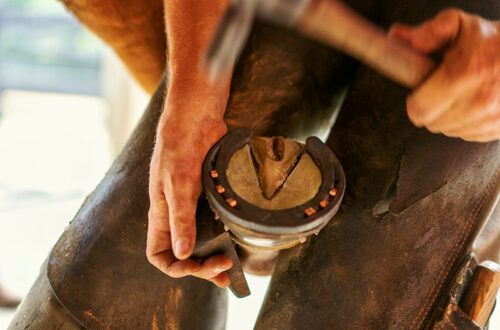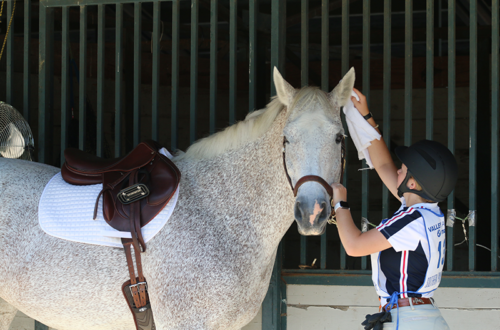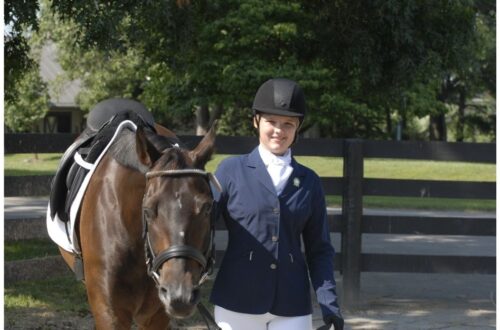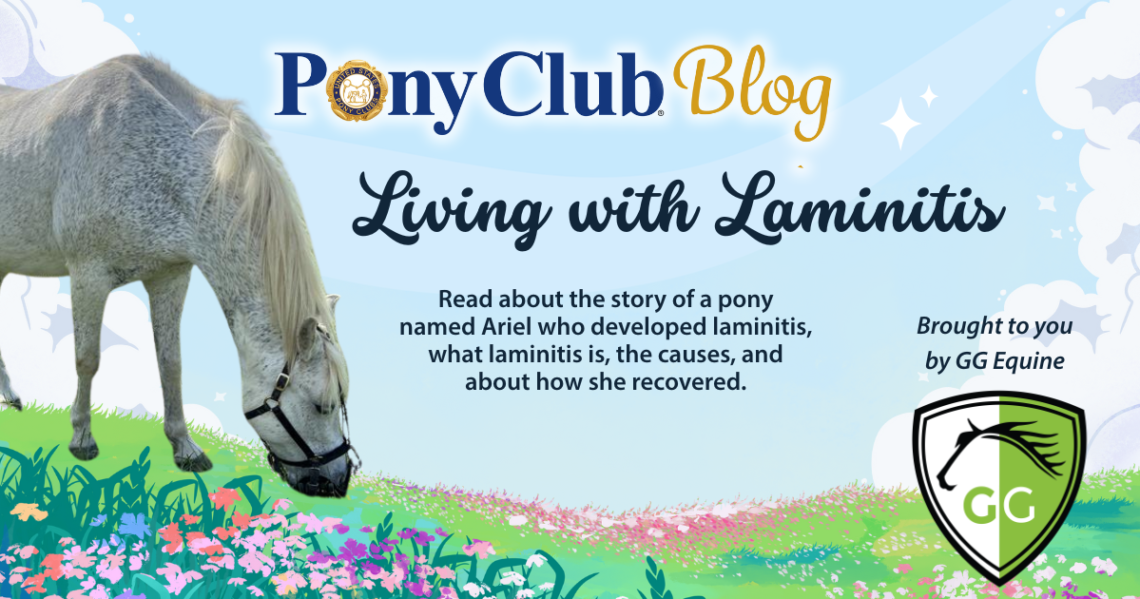
Laminitis: A Story of One Pony’s Recovery
By Connie Jehlik, USPC Instruction Services Director; Brought to you by GG Equine

In March of last year, our Welsh Pony, Ariel, developed laminitis, a serious metabolic condition that causes painful swelling within a horse’s hooves. Rich pasture grass is a common cause of laminitis, so we are always very careful about Ariel’s diet. In the winter, when grass dies and we feed hay, she is normally able to go out safely in the pasture for two to three months without a grazing muzzle. Grazing muzzle allow horses to still enjoy turnout time but limits the amount of grass they can eat. However, as the green grass started to emerge, we missed the right timing for putting Ariel’s muzzle back on.
In a one-week period, Ariel went from being happy and moving normally to being off her feed and not wanting to walk. We quickly realized what was happening and began treatment with stall rest in deep bedding and soaking her front feet in cold water. If you think your horse has laminitis, it’s important to contact your veterinarian and begin treatment immediately. Don’t wait, or it can get much worse quickly! The treatment seemed to help Ariel, along with medication to relieve pain and reduce the swelling, but after a week, we knew she needed more help. After speaking to our veterinarian, Ariel was sent to an equine hospital where she could see a specialist—in this case, an equine podiatrist who focuses on hoof problems.
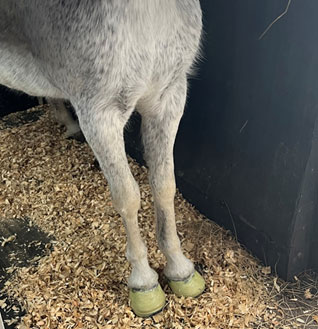
At the equine hospital, Ariel received excellent care and walked out the same day wearing special shoes. She was no longer in extreme pain. We had been checking for any rotation of the coffin bone (a crucial bone in the hoof), which can occur in laminitis, and luckily, she had minimal coffin bone movement, so we caught it in time. However, Ariel developed hoof abscesses twice over the next few months, which is fairly common. That set her back a bit, but she made a full recovery. A year later, she still wears shoes with low pads, and she is back to normal with lots of love from the grandchildren. Laminitis tends to re-occur, so we will always need to keep a close eye on her.
What is Laminitis?
Laminitis tends to be more common in ponies than horses. Severe cases can lead to founder, which is when the coffin bone inside the hoof is affected, and you may hear the terms used interchangeably. Laminitis is a serious metabolic disorder that can cripple a pony or horse. A metabolic disorder means that something is wrong with the horse’s ability to process and distribute nutrients, such as proteins, fats, and carbohydrates. When the body is not processing these nutrients properly, the blood flow in the feet can be affected, causing inflammation of the sensitive laminae inside the hoof. Laminae are finger-like interlocking tissues that attach the hoof wall to the coffin bone. Inflammation causes the laminae to weaken their hold on the coffin bone, which then allows the coffin bone to rotate down towards the sole (bottom of the hoof), and this causes extreme pain.
Laminitis often affects multiple feet. The possible movement of the coffin bone might not be exactly the same in each affected foot. Also, sometimes horses overcompensate and put more weight on a non-affected limb, which can then cause issues in the non-affected from bearing his weight unevenly. Asking your veterinarian to x-ray each affected limb can help determine how much the coffin bone might have moved, and this allows your veterinarian to recommend treatment. Because the hoof cannot expand, swelling inside the hoof is extremely painful. The hoof may feel hot to the touch, and the horse or pony may stand with his front feet out in front of him to take the weight off of his feet. If laminitis occurs in all four feet, the laminitic horse might not even want to stand and will lie down and not be willing to get up. This is a serious situation, and you should call your veterinarian immediately.
Causes of Laminitis
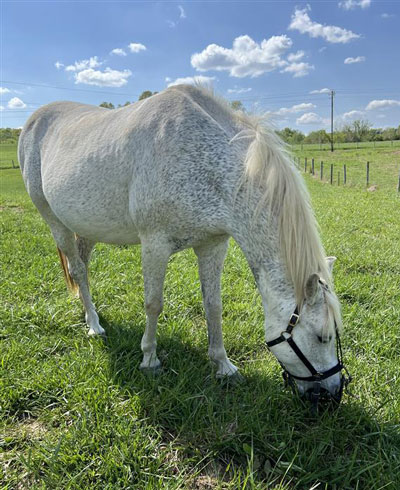
There are other ways that a pony or horse might develop laminitis, but grazing on rich pasture is the most common cause. Equines who have been diagnosed with pituitary pars intermedia dysfunction (PPID, also called equine Cushing’s disease) are at a greater risk of laminitis, as well as any pony or horse that gets into a grain storage bin and consumes a large quantity of grain. This is why it is so important to make sure horses cannot get into the feed room and that grain is securely stored. Also, never feed horses any type of feed meant for other livestock, such as cattle or pigs, as these feeds contain additives that can cause laminitis. Another caution is to always know the source of any shavings used for bedding, because shavings from black walnut trees can also cause laminitis in horses due to an absorbable toxin in the bedding, and they should never be used for horses.
Keep an eye out for any horse or pony that is overweight, and that has fat deposits, as this is a major risk factor for laminitis. Overweight horses and ponies will show fat deposits along the crest of the neck, the back, and the rump, and even at the tailhead. Cutting back that horse’s food intake and increasing exercise are the best ways to reduce fat deposits and the risk of laminitis. Turnout with a grazing muzzle or in a dry lot without grass may be necessary to get his weight under control.
Preventing Laminitis
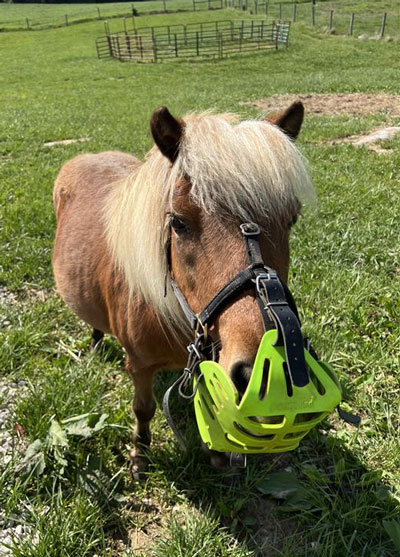
How can you prevent laminitis in the first place?
- Pay close attention to what your horse is eating, both in quantity and quality.
- If on pasture grass he may need a grazing muzzle seasonally, from March to December, for example, or all year long, depending on the environment where he lives.
- Monitor how much exercise your horse is getting, and feed according to the work being done.
- Age and body condition (weight) should also be a factor in his feeding program.
- Make sure all grain, supplements, and rich hay, such as alfalfa, are stored in a safe and secure place.
A Pony Living with Laminitis
Today, Ariel is happy and healthy. She is able to enjoy going out in the pasture during the day while wearing her grazing muzzle, and she goes into her stall at night. She has a Miniature Horse friend to keep her company, and three children that love her. Because of her history of laminitis, we watch Ariel’s weight and diet carefully. She has special shoes, and we keep an eye out for any signs of pain in her feet. With good care, she should continue to live a long and happy life.

About GG Equine
GG Equine believes in slow feed solutions that work with your horse—not against them. From better posture with our HayPlay Bags to natural grazing behavior with our low-stress GreenGuard Muzzles, we help you support your horse’s wellness from the ground up. Learn more at gg-equine.com.




